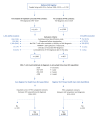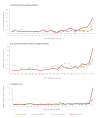Use of healthcare services preceding HIV diagnosis - missed opportunities for earlier diagnosis, Finland, 1996 to 2019
- PMID: 40341103
- PMCID: PMC12066979
- DOI: 10.2807/1560-7917.ES.2025.30.18.2400610
Use of healthcare services preceding HIV diagnosis - missed opportunities for earlier diagnosis, Finland, 1996 to 2019
Abstract
BackgroundHIV testing based on indicator conditions is recommended to diagnose HIV earlier.AimOur aim was to assess opportunities for earlier diagnosis of HIV.MethodThis is a retrospective study on people living with HIV (PLWH) included in the national HIV register. We collected data on public primary outpatient healthcare (PHC) (2011-2019), secondary and tertiary outpatient healthcare (STHC), and all inpatient care (1996-2019) from the Care Register for Health Care from the presumed acquisition, estimated by CD4+ T-cell count at diagnosis, until the diagnosis of HIV.ResultsOf 907 PLWH diagnosed between 2011 and 2019, 522 (58%) had ≥ 1 healthcare contact at any level between HIV acquisition and > 30 days before diagnosis. At least one European Centre for Disease Prevention and Control (ECDC) indicator condition was recorded for 119 (23% of 522), and 112 (21%) were born in a high-prevalence country. In total, 384 of 907 (42%) had visited a PHC physician, and 58% of those with CD4+ T-cell count < 200 cells/μL at diagnosis. Of 2,082 PLWH diagnosed between 1996 and 2019, 869 (42%) had STHC outpatient contacts > 30 days before diagnosis, 18% with ≥ 1 ECDC indicator condition, and 367 (18%) had been hospitalised, 20% with ≥ 1 ECDC indicator condition. The most common ECDC indicator conditions > 30 days before diagnosis at all levels of healthcare were pneumonia, sexually transmitted infections, unexplained fever, herpes zoster, pregnancy and lymphadenopathy.ConclusionWe recommend enhancing indicator condition-based HIV testing by all healthcare providers, particularly for gonorrhoea, syphilis and, for persons younger than 50 years, also herpes zoster and lymphadenopathy.
Keywords: Delayed diagnosis; Finland; HIV; Health Services.
Conflict of interest statement
Figures
Similar articles
-
Prevalence of HIV indicator conditions in late presenting patients with HIV: a missed opportunity for diagnosis?QJM. 2019 Jan 1;112(1):17-21. doi: 10.1093/qjmed/hcy223. QJM. 2019. PMID: 30295832
-
Missed opportunities for early HIV diagnosis in Greece: The MORFEAS study, 2019 to 2021.Euro Surveill. 2024 Nov;29(48):2400138. doi: 10.2807/1560-7917.ES.2024.29.48.2400138. Euro Surveill. 2024. PMID: 39611208 Free PMC article.
-
Missing the mark: ongoing missed opportunities for HIV diagnosis at an urban medical center despite universal screening recommendations.Fam Pract. 2016 Dec;33(6):644-648. doi: 10.1093/fampra/cmw075. Epub 2016 Aug 9. Fam Pract. 2016. PMID: 27507566
-
Missed opportunities for HIV testing in people diagnosed with HIV, Estonia, 2014 to 2015.Euro Surveill. 2019 Apr;24(15):1800382. doi: 10.2807/1560-7917.ES.2019.24.15.1800382. Euro Surveill. 2019. PMID: 30994106 Free PMC article.
-
Late presentation to HIV care despite good access to health services: current epidemiological trends and how to do better.Swiss Med Wkly. 2016 Aug 21;146:w14348. doi: 10.4414/smw.2016.14348. eCollection 2016. Swiss Med Wkly. 2016. PMID: 27544642 Review.
References
-
- European Centre for Disease Prevention and Control (ECDC). Public health guidance on HIV, hepatitis B and C testing in the EU/EEA An integrated approach. Stockholm: ECDC; 2018. Available from: https://www.ecdc.europa.eu/en/publications-data/public-health-guidance-h...
MeSH terms
LinkOut - more resources
Full Text Sources
Medical
Research Materials


